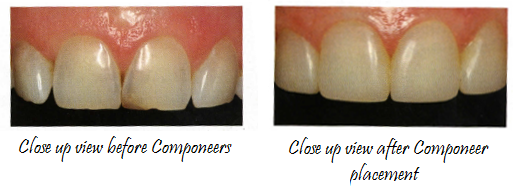Instant Cosmetic Smile Enhancement with Componeers
Written by Ross Nash, DDS Last modified on May 4, 2018
Two of the most common lines of questioning I get from patients are “what can I do to improve my smile?” and “how long will it take to achieve the results I’m looking for?” With that in mind, I thought I’d devote this ‘Ask the Expert’ installment to a discussion of a relatively new type of esthetic restoration called Componeers that cater to people seeking a quicker brand of smile enhancement without sacrificing durability.
Q. What is a Componeer?
A. A Componeer is a new direct composite veneer from Switzerland-based dental product manufacturer Coletene.
A direct veneer can be used to give a tooth a new and improved surface, and repair broken or decayed teeth, as well as to change the color, shape or alignment of the teeth. However, the final esthetic result of direct veneers is dependent on the skill and artistry of the provider of the treatment. This equates to a certain degree of variability that could potentially result in patient dissatisfaction.
A Componeer is different in that it is a pre-formed surface with all of the artistry built in. By taking the variability associated with traditional direct veneers out of the equation, patients are able to better see and gauge the expected outcome prior to treatment.
Componeers can improve the final surface of the teeth, while shortening the time needed to place a direct composite resin veneer.

Q. How much do Componeers Cost?
A. Componeers can be placed at fees that are very affordable for many more people today. The cost of Componeers is typically less than the cost of porcelain veneers (which can range from $1,000 to $2,500 per tooth). However, the exact cost depends on a variety of factors, including where the procedure is performed and its extent.
Q. Are there advantages of Componeers over porcelain veneers?
A. Porcelain veneers are considered to be the most durable and long lasting of veneers, but composite resin veneers have some advantages. They are resilient and will absorb stress from chewing and clenching. One of the primary benefits Componeers have over porcelain veneers is that they require minimal or no tooth reduction for placement. Traditional porcelain veneers typically require the permanent alteration of the natural teeth in order to comfortably fit the thicker porcelain shell over the tooth naturally.
Additional advantages of Componeers are that they can be easily repaired and they will not wear away apposing tooth structures. They can be placed at a lower cost and the esthetic result can be controlled by the provider of the treatment.
Q. How long can Componeers be expected to last?
A. A well-placed composite resin veneer can be expected to last five to ten years (or more). The dense and durable surface of the Componeer may help provide a longer lasting and more stain resistant direct veneer option.
If you’re interested in learning more about Componeers, or have additional questions about how treatment compares with porcelain veneers, your best port of call is a qualified dentist. During your consultation, your dentist will be able to provide more specific information about your custom treatment and answer your questions related to cost and durability.


